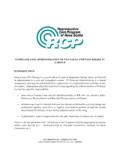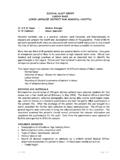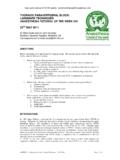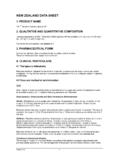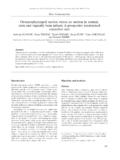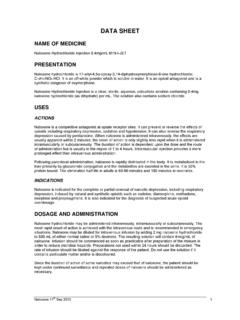Transcription of Augmentation of labour - nfog.org
1 Augmentation of labour Torbj rn Moe Eggeb . Stavanger University Hospital Janne Rossen. S rlandet sykehus Kristiansand. Liv Ellingsen, Oslo University Hospital. Helene Christine Heide, B reum Hospital Saba Muneer. Akershus University Hospital. Stian Westad. Lillehammer Hospital. Recommendations Definition of start of labour (strong recommendation) Definition of start of active labour , WHO definition (4 cm cervical dilation and regular contractions (recommendation) Use of a partogram (strong recommendation) Definition of slow progress (strong recommendation) Use of alert line and action line (recommendation) Use of WHO's definition with action line delayed by 4 hours (suggestion) Other measures to stimulate contractions such as encouraging the adoption of mobility and upright position, empty the urine bladder and offer oral fluid and food intake before the action line is crossed (proposal) One to one support (strong recommendation) Amniotomy before oxytocin Augmentation (strong recommendation))
2 Augmentation with oxytocin is recommended in women with slow progress due to insufficient contractions (strong recommendation) Oxytocin Augmentation may be relevant in nulliparous women with ineffective contractions in latency phase and effaced cervix dilated <3-4 cm (proposal) Fetal surveillance with CTG should be used in all women accelerated with oxytocin. (strong recommendation) Consider operative delivery after one hour with active pushing (recommendation) Litterateur search Up to date, pub-med, National Institute for Health and Clinical Excellence guidelines, Cochrane Database, guidelines from the Royal College of Obstetricians & Gynaecologists, Danish and Swedish guidelines. Definition The process of stimulating the uterus to increase the frequency, duration and intensity of contractions after onset of the active phase of labour Hyperstimulation is defined as > 5 contractions / 10 min or duration of the contraction > 2 minutes1.
3 Stimulation of contractions should be regarded as the continuation of a physiological process the body itself has already started (as opposed to induction of labor)2. Stages of labour The birth contains three stages. First stage lasts from the start of contractions until the cervix is completely dilated. This stage is divided into a latency phase and an active phase. The active phase starts, in accordance to the WHO's definition, when cervix is dilated to 4 cm in a woman with regular contractions3-6. Some will define the start of active phase earlier if cervix is effaced. The second stage lasts from cervix is fully dilated until the child is delivered and this stage is also divided into a latency phase (until leading part has reached the pelvic floor) and an active phase (time of bearing down)5.
4 The third stage is the time from the child is born until the placenta is expelled. The partograph Partographs have not documented differences in perinatal or maternal morbidity or mortality7 and a Cochrane review concludes that the benefits of using a partograph are not documented8. Nevertheless, the partograph is the most important tool in surveillance of labour progress, and use of a partograph is strongly recommended9 [IV]. Cervical dilation and station is recorded graphically in the partograph. WHO recommends a partograph with an alert line and an action line delayed 4 hours. The alert line follows 1cm dilatation / hour. WHO partograph with alert line and action line Slow progress No evidence for an upper limit of normal duration exists10 or the definition of how slow progress should be defined11.
5 However, all labour wards should have their own guideline defining slow progress to avoid incautious use of oxytocin augmentation12. Structured care during birth improves outcomes13 [Ib]. First stage The latency phase can last up to 20 hours in nulliparous and 14 hours in multiparous women3, 14. Generally it is recommended that women stay at home in the latency phase, because hospitalisation is associated with increased use of obstetrical interventions15 [Ib]. However, some women need hospitalization and analgesia. The follow-up should be individualised5. Epidural analgesia can be started in the latency phase without prolonging the labour16. Several definitions of slow progress in the active phase of labor exist. When cervical dilatation crosses the alert line WHO partograph with four hours delay between alert line and action line6, 17 3 hours between the lines18 2 hours between the lines7 No change in dilatation or station within two hours3 <2cm change in dilatation during four hours5 Slow progress in the first stage active phase3 < cm / hour in nulliparous women < / hour in multiparous women In a prospective study women using action line two hours delayed were most satisfied19, but the use of action line earlier than four hours increases the need of Augmentation without better birth outcomes5, 8 [Ib].
6 NICE guidelines suggest using the WHO recommendations5, and we agree. Second stage Active pushing should not start until the fetal head has reached the pelvic floor unless an immediate birth is needed due to fetal distress or suspected infection. Several labour wards practice one hour as limit for the duration of the latency phase, but other wards accept two hours. Evidence of best practice is limited. Some countries allow two hours of bearing down in nulliparous women5, but it is shown that active pushing exceeding 30 minutes is associated with increased risk of asphyxia. The probability of spontaneous delivery decreases with duration of bearing down20 [Ib]. We suggest considering an operative delivery after 60 minutes of active pushing both in nulliparous and multiparous women.
7 This recommendation should also be applied in women with epidural analgesia. Causes of slow progress Slow progress in labour may be due to ineffective contractions, malpresentations, fetal-maternal disproportions (pelvis and passenger) or a combination of these factors. Problems are more common in nulliparous women. Oxytocin Augmentation is only indicated in cases with insufficient contractions. A clinical examination is indicated when slow progress is diagnosed. Recent studies have shown that fetal position and level can be assessed by ultrasound21 , but routinely use cannot be recommended due to limited evidence22. Malpresentations as brow, mento posterior or transverse face presentations or posterior asynclitism are incompatible with vaginal birth, but the malpresenataions often change spontaneously.
8 Most fetuses in occiput posterior position will rotate spontaneously (also in the second stage)22 [IIb]. Actions when slow progress is suspected All women in the latent phase should be offered a meal. Eating and drinking is also important in the active phase and might effect the duration of labour23, 24 [III]. Empty the urinary bladder Change maternal position and recommend activity One to one supervision increases the likelihood of an uncomplicated vaginal delivery25 [Ia]. Some studies have shown that acupuncture can shorten duration of labour26, 27 [Ib]. Amniotomy shortens duration of labour , but routinely amniotomy is not recommended11, 28. The combination of amniotomy and Augmentation with oxytocin is more effective than the use of the factors alone29 [Ib]. Amniotomy should be performed before oxytocin Augmentation is started Oxytocin Augmentation Oxytocin Augmentation is recommended in women with ineffective contractions.
9 Oxytocin Augmentation shortens birth outcomes [Ia], but an eventual reduction in instrumental delivery is not documented, although the drug has been used for this indication in over 40 years1, 30, 31. Clinical assessment of the strength of contractions is subjective. A huge variation in the use of oxytocin Augmentation is published, 32-60% among nulliparous women and 14-27% in parous women32, 33. One Swedish study has documented that the use of oxytocin is unstructured12. Oxytocin Augmentation does not affect the frequency of instrumental vaginal deliveries in women with epidural analgesia34. In a randomised controlled trial early Augmentation with oxytocin was not associated with better birth experience35. Risks associated to prolonged labour Prolonged latency phase and prolonged active birth has been associated with operative vaginal birth, cesarean sections, chorioamnionitt, postpartum haemorrhage, low Apgar scores, and poor birth experience causing request for cesarean section in the next birth19, 36-42.
10 The partograph is an important tool in recording labour progress, indications of oxytocin Augmentation and indications for operative interventions9. One to one supervision is important when the progress in slow25. Risks associated to oxytocin Augmentation Oxytocin is a drug with side effects and misuse may cause serious damage to the mother and fetus43. The sensitivity of the drug is individual, and the Augmentation should be individualised1. Hyperstimulation might affect the placental circulation causing fetal distress1, 44, 45. Hyperstimulation is one of the main causes of birth asphyxia43, 46, 47. Oxytocin Augmentation is also associated with uterine rupture, especially in women with a previous scar in uterus48, 49. Two special managements Active management of labour2 This concept from the National Maternity Hospital in Dublin includes: One to one follow-up Duration of the active stage <12 hours Definition of active phase Routinely amniotomy Vaginal examination every second hour Oxytocin acceleration in women with cervical dilatation <1cm/hour after two hours in active phase in nulliparous women and after four hours in multiparous women.

